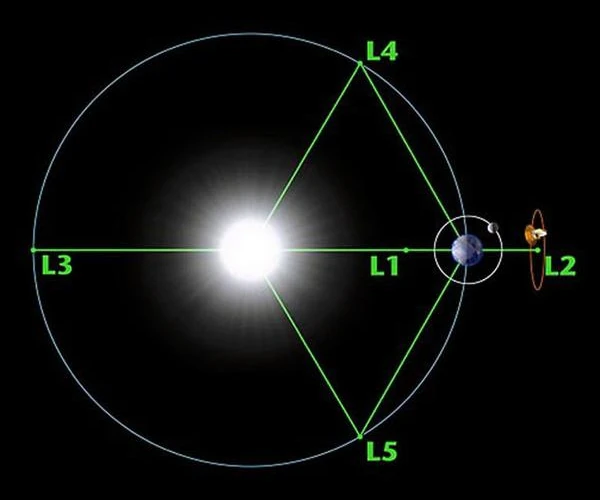
The Lagrange points, named after the mathematician Joseph-Louis Lagrange (1736-1813) who described them in 1772, are stable orbital positions between two bodies in the solar system. These five points (L1, L2, L3, L4, L5) are where gravitational forces and centrifugal force perfectly balance each other.
In other words, Lagrange points are like "natural stations" in space where the gravity and rotation of the Sun-Earth system cancel each other out. They offer ideal positions for placing satellites or observing the Universe without constant gravitational disturbances.
The L1 point, located between Earth and the Sun about 1.5 million kilometers from our planet, offers a unique position for uninterrupted solar observation. The SOHO (Solar and Heliospheric Observatory) probe has been stationed there since 1995, providing crucial data on solar activity.
Opposite L1 relative to Earth, L2 hosts observatories such as the James Webb Space Telescope (JWST) and Gaia. Shielded from direct sunlight by Earth, L2 enables stable infrared astronomical observations of deep space (at -233°C).
L3 is located on the far side of the Sun relative to Earth. Very difficult to reach and observe from Earth, it remains mostly theoretical for studies in celestial mechanics and simulations. There are no missions at L3.
Always hidden behind the Sun, L3 has inspired fiction but has little practical interest.
Forming equilateral triangles with the Sun and Earth, L4 and L5 are the only naturally stable points. This means that asteroids or satellites can remain there for a long time. L4 is ahead of Earth in its orbit, L5 is behind.
| Point | Relative position | Stability | Main uses | Example missions |
|---|---|---|---|---|
| L1 | Between Earth and the Sun | Unstable | Solar observation, space weather, relay satellites | SOHO, DSCOVR |
| L2 | Beyond Earth, opposite side from the Sun | Unstable but accessible | Astronomical observatories, cosmology, communication with interplanetary probes | JWST, Gaia |
| L3 | On the far side of the Sun relative to Earth | Unstable | Theoretical, trajectory planning, simulations | No current missions |
| L4 | Ahead of Earth in its orbit, forming an equilateral triangle with the Sun and Earth | Stable | Study of Trojan asteroids, navigation beacons, gravitational experiments | Jupiter Trojan asteroids |
| L5 | Behind Earth in its orbit, forming an equilateral triangle with the Sun and Earth | Stable | Study of Trojan asteroids, long-term observatories, navigation beacons | Jupiter Trojan asteroids |
Lagrange points are not only used for placing telescopes or observing asteroids. They also offer considerable advantages for space navigation and planning interplanetary trajectories.
A satellite positioned near a Lagrange point benefits from a quasi-stable balance between the gravitational forces of two main bodies (such as the Sun and Earth). This allows for reduced fuel consumption to maintain a fixed position or specific orbit, which is crucial for long-distance missions.
For example, L1 and L2 serve as relay points for communications with interplanetary probes, as satellites at these points can observe or transmit data without interruption caused by Earth's rotation. Trajectories to Mars, Venus, or other destinations can be optimized using gravitational pathways that "glide" around Lagrange points, thus minimizing propulsive maneuvers.
Finally, L4 and L5, due to their stability, can host long-term stations or relay satellites, serving as navigation beacons for future space missions. These points can also be used to study the stable gravitational environment to test new navigation and orbit technologies.